RECOIL OFFGRID Gear EDC Belt, Range Belt, and War Belt Setups
In This Article
Humans have been making clothing with built-in pockets since at least 1200 AD, when our ancestors started cutting slits in their tunics to access coin purses or keys stashed in their undergarments. However, the concept of storing tools on a belt is far older than that of carrying them in our clothes. The frozen body of Ötzi the iceman, who is believed to have died between 3400 and 3100 BC, was found clad in a leather belt. Pouches sewn onto his belt contained a scraper, drill, awl, and fire-starting kit with flint and tinder fungus. Ever since those ancient times, utility belts have seen continuous use, carrying everything from primitive survival supplies and farming implements to swords and six-shooters. They offer quicker access and more load-carrying capability than garment pockets, and can be configured in countless ways to meet the task at hand. With this in mind, let’s take a look at three common categories of belts related to emergency preparedness and self-defense. We've divided them into three categories: EDC Belt, Range Belt, and Battle Belt/War Belt, each for their own purpose. But if you're in a hurry, check out this video on one man's custom range belt setup:
First, everyday carry belts are designed to be slim and comfortable enough for daily wear. Most are intended to provide additional support for concealed carry of a gun, medical gear, and other items. EDC belts also offer higher load-bearing capacity for pants that are weighed down with anything beyond the normal phone, keys, and wallet.
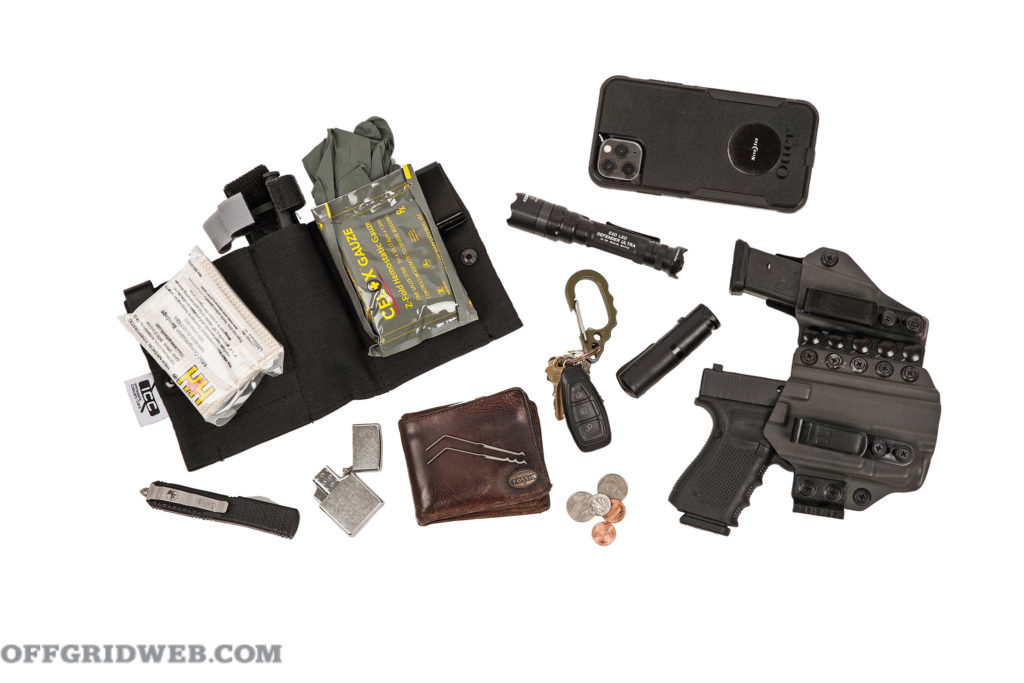
Above: A good belt makes it easy to carry gear without constantly stopping to hike up your pants. The pictured Agis appendix holster from Tier 1 Concealed distributes weight well thanks to two clips and a flexible midsection.
Second is the category we refer to as range belts — the type you’d wear at a shooting class or competition. These tend to be more overt and sturdy; items that were stored inside the waistband (IWB) are now stored outside the waistband (OWB), and additional magazine and accessory pockets are added. Range belts sometimes feature a thin inner belt and detachable outer belt connected by hook and loop material, making it easy to tear off the entire loadout in seconds without dropping trou. Buckles and webbing tend to be larger and stronger, since concealment is no longer a priority.
Finally, battle belts or war belts are the most high-profile and full-featured category. Even if you’re not literally going into combat, these setups are made to handle that level of physical activity and abuse. This is where you’ll typically see more mission-driven gear loadouts, padded layers for comfort during extended wear, and in some cases, active retention holsters that restrict unauthorized access to a handgun. You might think every inch of these belts will be packed with gear, but that’s not necessarily true. A war belt or battle belt is often worn as one part of a larger load-bearing system, so some of the equipment may migrate off the waistline and onto a chest rig, vest, or plate carrier. Refer to our article “Front Toward Enemy” in Issue 36 for a thorough look at each of those systems.
Now that you understand the divisions between these three types of belts, buckle up and read on as we show some of the options and considerations for each. All of the following belts and accessories from Carbon Tactics, G-Code, and Snake Eater Tactical are made in the USA.
Whether you’re wearing a suit and tie or jeans and a T-shirt, there are EDC belt options that complement almost any type of attire. I tend to fall into the latter category most of the time, so my belt stays concealed beneath the hem of my T-shirt. Thankfully, this means I’m not restricted to styles that look like they belong on the shelf at Men’s Wearhouse.
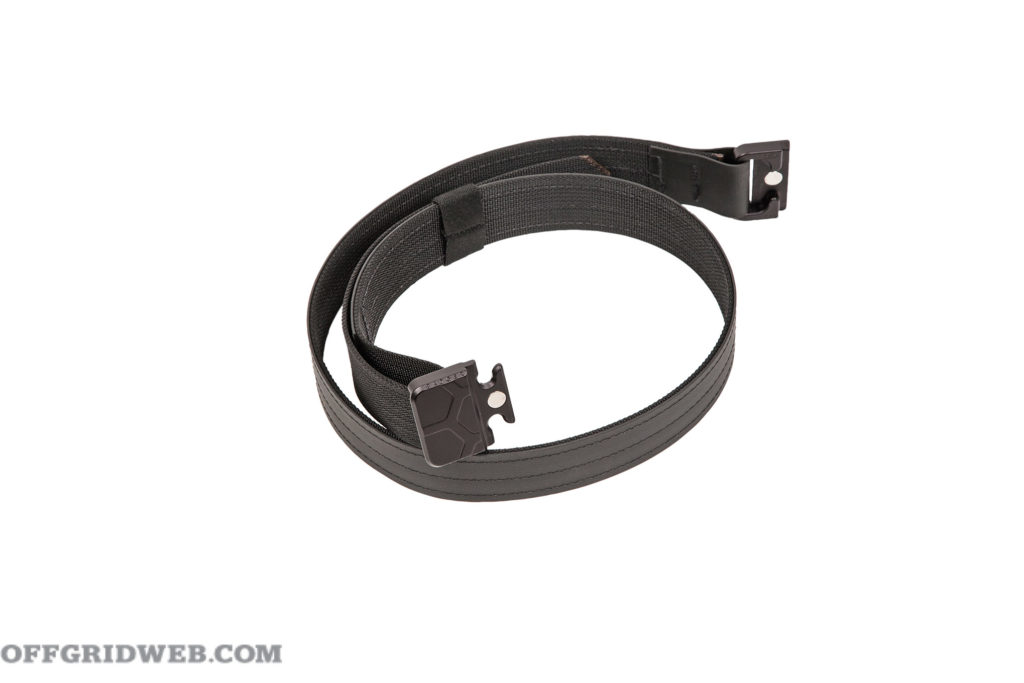

Above: A strong magnet embedded in the BadgerStrap causes the split buckle to snap together with a satisfying click.
The Foundation: I picked up two belts from Carbon Tactics, a company that designs and manufactures its products in my home state of Arizona. The first is called the BadgerStrap, and consists of a clever split buckle that’s held in place using a strong magnet and CNC-machined, interlocking latch. Although the BadgerStrap was recently discontinued, Carbon Tactics offers the Quicky with a similar magnetic mechanism, as well as the new Cipher, which augments the magnetic latch with a tensioner dial. All of the company’s belts are available with single-layer (more flexible) or double-layer (more rigid) nylon webbing in your choice of black, gray, or coyote brown. A hybrid Biothane option is also offered, integrating an outer layer of polyester webbing coated in tough thermoplastic polyurethane (TPU). I chose this option since it prevents fraying or staining, and makes the belt slightly stiffer than a single-layer style.
The BadgerStrap’s magnetic buckle is rock solid — allegedly strong enough to lift a motorcycle — and I like the fact that its styling is relatively inconspicuous. The nylon and Biothane hybrid construction is supportive without being excessively stiff. I noticed the BadgerStrap has a tendency to loosen slightly throughout the day, especially when it’s loaded with a holster or other heavy items. The brass slider on the male side of the buckle doesn’t grip the webbing as securely as I’d like. That said, this belt is a great choice for those who prefer minimalist loadouts without too much weight on the waistband.
Carbon Tactics also provided a second belt, the Epoch, which demonstrates a heavier-duty EDC option. This belt’s CNC-machined buckle features a trigger-shaped release mechanism on the female side of the buckle. This looks cool, and allows for easy one-handed opening. Apparently, the filmmakers behind the 007 series also liked the design, since this belt is featured in the recent movie No Time to Die. Another benefit of the Epoch is its ability to fit through belt loops; unlike the split-buckle BadgerStrap and Quicky models, you won’t need to slide the Epoch’s buckle off the webbing to swap it between pairs of pants. As for the webbing, this belt features double-layer Coyote Brown nylon.
Carbon Tactics Epoch Coyote Double-Layer
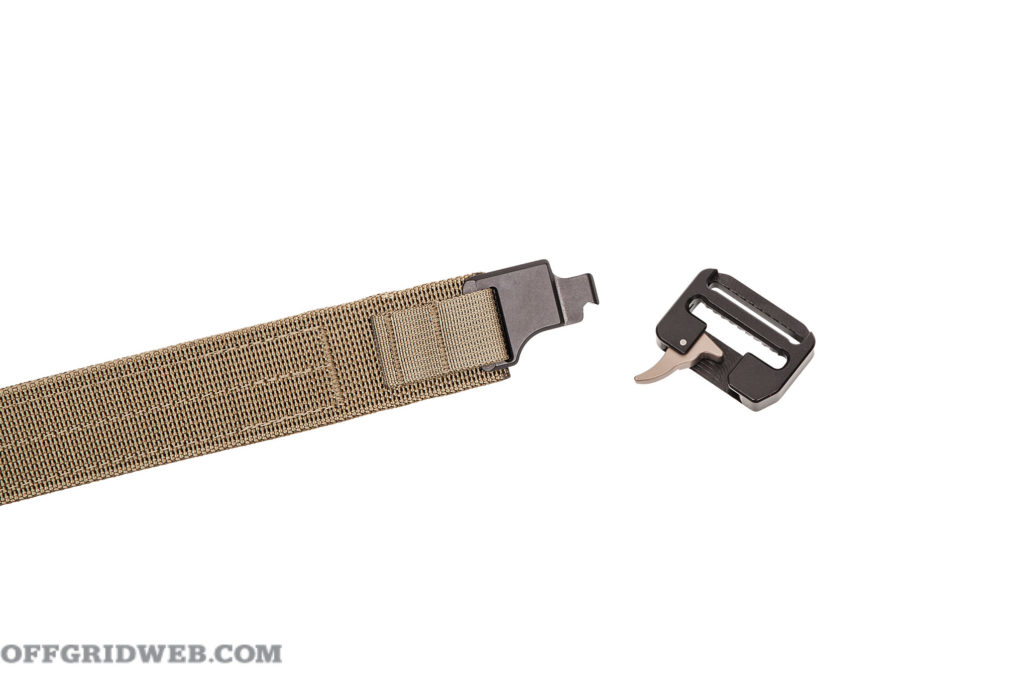
Above: The Carbon Tactics Epoch features a unique trigger release mechanism, but our favorite part about this design was the fact that it’s slim enough to slide through belt loops without removing the buckle.
I found the Epoch buckle design to be more comfortable and convenient than the BadgerStrap; it’s slimmer and has built-in flexibility between the male and female halves of the buckle, allowing it to contour to my waist. I also didn’t have any issues with this belt loosening during the day, even with a holster, spare mag, and trauma kit inside my waistband. Some users may find the double-layer nylon to be too stiff — it holds a semi-rigid oval shape at all times. It can be ordered with single-layer or hybrid webbing, depending on the user’s preference and load-bearing needs.
I tried out two different holsters with these belts — one made specifically for appendix carry with a spare mag, and a more traditional stand-alone option with a separate mag carrier.
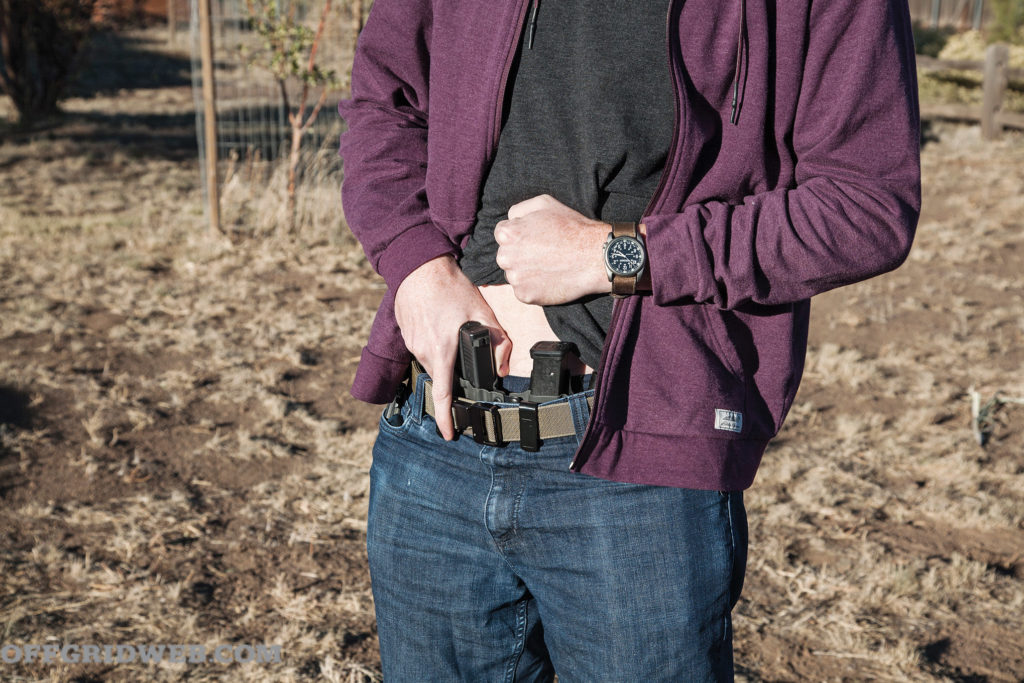
Notes: The Agis is designed for appendix carry, and includes a detachable magazine carrier. Many colors and configurations are available; shown is Storm Gray Kydex set up for a Glock 19 and Streamlight TLR-7A weapon light. With its canted spare magazine, adjustable clips, concealment claw, and flexible midsection, I found this holster to be extremely comfortable and easy to conceal under a T-shirt.
Tier 1 Concealed Agis Holster
Notes: Modular appendix holsters aren’t everyone’s cup of tea, so I also tried out a stand-alone holster and mag carrier from VEIL Solutions. This holster is set up for my G19/TLR-7A, and it works well for either appendix or strong-side carry. The MOD Wing helps reduce printing, and the optional Discreet Carry Concepts clips make sure it doesn’t move around on my belt. The C2 mag carrier is the same durable Kydex design featured on the war belt/battle belt setup later in this article, but reversed for IWB wear.
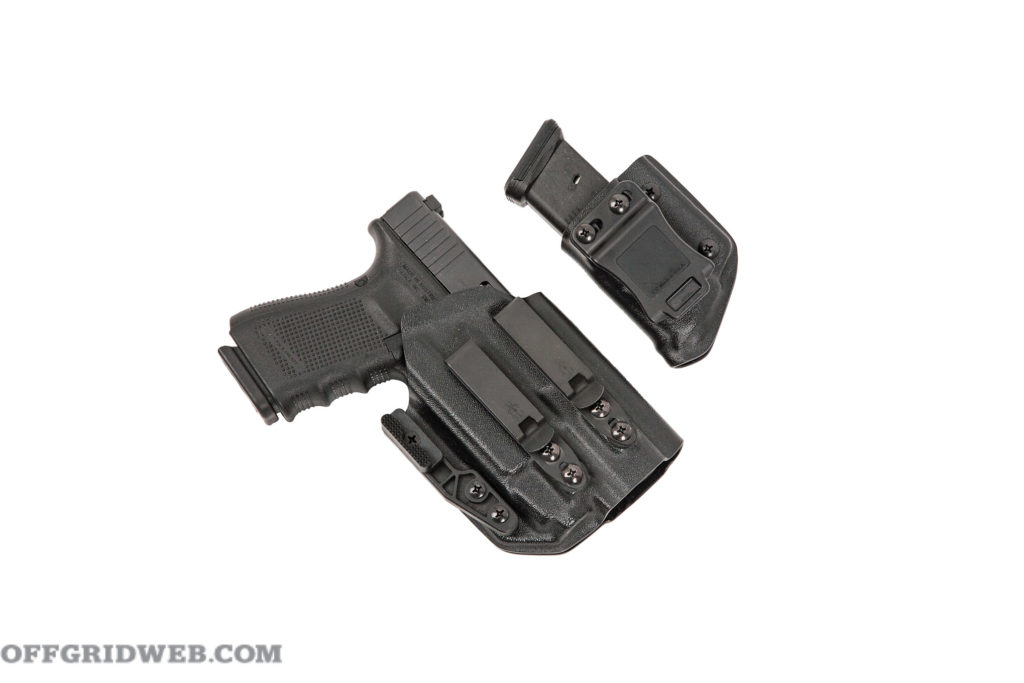
Above: VEIL Solutions’ Mantis light-bearing holster provides a minimalist way to carry my Glock 19 and Streamlight TLR-7A. Its metal DCC clips ensure it won’t budge or slide on my belt.
VEIL Solutions Mantis Holster and VEIL Solutions C2 Glock Mag Carrier
I believe every prepared individual should have basic medical gear and Stop the Bleed or equivalent training. I always carry a bigger kit in my backpack, but an IWB IFAK ensures I’m never without the most critical life-saving gear.
Immediate Casualty Care Min-E-Med IWB Flat
Notes: When I first saw this elastic med kit, I wasn’t sure if it’d end up being too bulky to wear every day. I soon learned it’s surprisingly slim and comfortable, even while sitting in a car for extended periods. It curves to fit my waist and holds a C-A-T tourniquet, H&H mini compression dressing, Celox hemostatic gauze, and gloves. Two metal clips hold the kit securely in place. My only gripe is that the TQ’s hook material sometimes snags on the inner hem of my T-shirt, causing it to fray; switching the C-A-T for a SOFTT-W will alleviate this.
Although the rest of my EDC gear isn’t directly attached to the belt, it’s indirectly supported by it. The more you fill your pockets, the more support you’ll need.
There are many instances where the amount of gear you can carry, and your ease of access to it, is more important than how discreet it appears. You might be hiking, camping, or hunting in the backcountry, or you might be in a setting where overt carry is expected, such as a gun range. For the sake of simplicity, we’ll refer to this category as range belts. They typically include two or more magazine pouches for primary and secondary weapons, a larger med kit, and an OWB pistol holster, plus any other pouches or tools you may need. Competition-oriented belts, such as those used in USPSA or 3-Gun matches, would technically fall into this category, but they’re much more specialized than the multipurpose setup seen here.
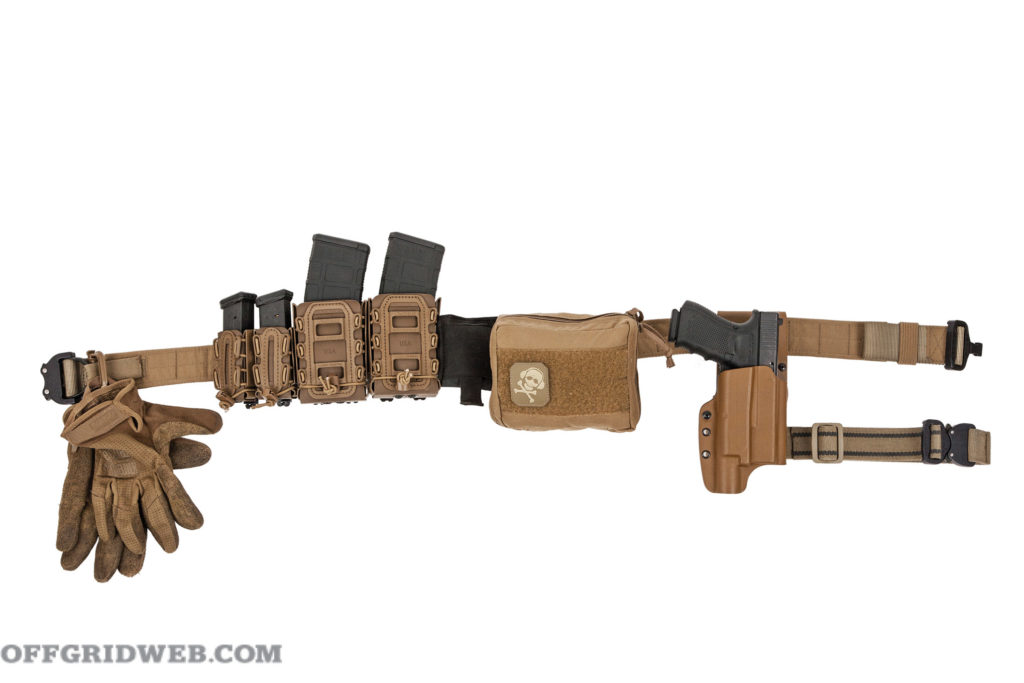
Above: If you’re looking for your first range belt, G-Code offers the Scorpion Low Viz belt as a complete kit with almost everything you’ll need. They’ll even ship it to you fully assembled — just clip on the RTI holster of your choice, and you’re good to go.
The Foundation: Although it’s certainly possible to piece together a range belt setup from off-the-shelf components, there are also several companies that offer range belt starter kits. I selected this G-Code Scorpion Low Viz Belt system, which is based around a two-piece Contact Series Operator’s Belt. Its 1.5-inch-wide inner belt fits through normal belt loops, and is Velcro-lined to attach to the outer belt. A G-hook secures the belt once it’s tightened. The outer belt is made from dual-layer 1.75-inch nylon, with the exterior layer wrapped in wear-resistant Cordura. A sturdy Cobra buckle is standard. Belts are available in black, OD green, coyote tan, wolf gray, MultiCam, or MultiCam Black.
Each Low Viz Belt kit comes with three G-Code Scorpion rifle mags, three Scorpion pistol mags, an Optimal Drop RTI pistol holster platform with elastic leg strap, and an RTI Rotating Belt Mount for an accessory of your choice. The latter two items are compatible with detachable holsters, pouches, and accessories that feature G-Code’s RTI mounting system. I found the belt kit to be very versatile, and have used it at Steel Challenge and 2-Gun matches, as well as for some of the pistol and carbine classes featured in my Final Weapon column.
G-Code’s RTI mounting system features three posts that lock into holes on the belt-mounted RTI plate. This allows the wearer to easily swap between holsters for different guns without a need for special tools or removal of the belt. Many manufacturers offer RTI-compatible holsters, but I decided to get a holster straight from G-Code along with my belt.
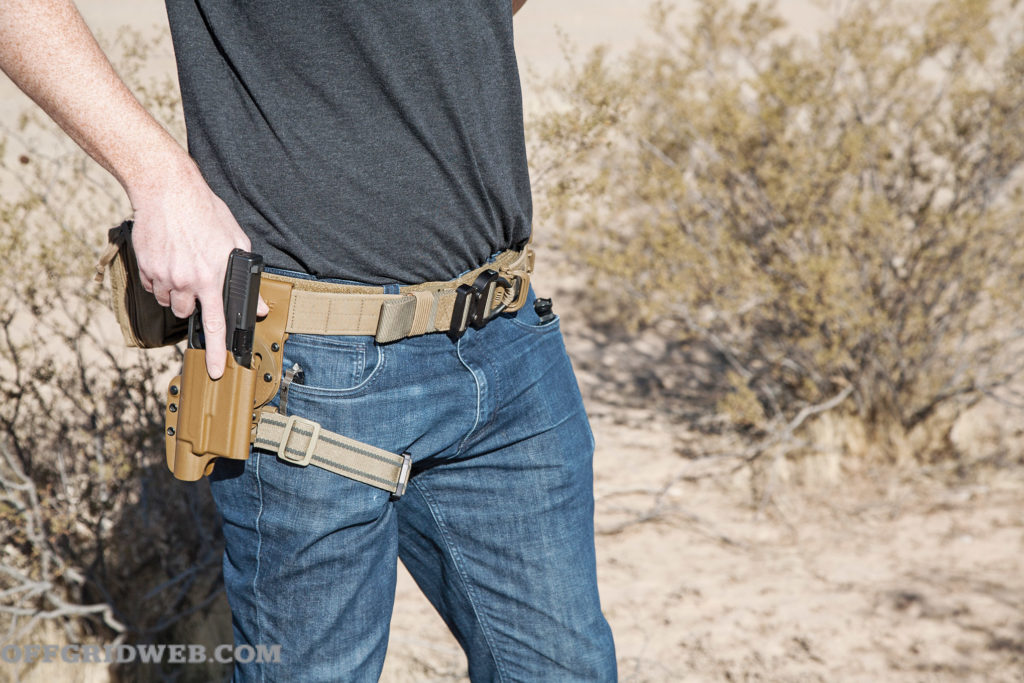
Above: The included Optimal Drop RTI mount positions the pistol grip even with the belt line, making it easier to draw quickly. It’s not nearly as cumbersome as an old-school drop-leg holster.
Notes: The OSLr features a pre-installed RTI hanger and sturdy Kydex construction in your choice of black, OD green, coyote tan, gray, or MultiCam. A soft “fuzz” finish is optional if you prefer that over bare Kydex. This holster feels well-made, with a positive click as my G19 slides into place. G-Code doesn’t offer a version that’s compatible with my current Streamlight TLR-7A carry light, so I went with the SureFire X300-U. I also selected the RMR cut option ($5 extra) and black anodized hardware (another $5). Paired with the Optimal Drop platform that came with the belt, the OSLr sits comfortably near the natural resting point of my hand, making it easier to draw quickly. The elastic strap prevents the holster from shifting as I run, kneel, or go prone.
A total of six soft magazine pouches were included with the Scorpion Low Viz belt kit.
G-Code Scorpion Low Vis Belt Kit
G-Code OSL RTI Kydex Holster
G-Code 6-Pack Scorpion Softshell Kit
Notes: These mag carriers are made from rubberized polymer woven together with elastic shock cord, which can be loosened or tightened to adjust retention. The rifle carriers can accommodate AR-15, AR-10, and AK magazines; the pistol carriers fit single- or double-stack mags and are available in Tall or Short (we chose Short for Glock 19 mags). This is a notable advantage over hard Kydex mag carriers if you plan to use your belt with a variety of weapon types. The elastic design does a good job holding mags in place, and allows them to be removed by pulling straight up or levering outward to break retention. R2 and P2 Operator mounts can be attached directly to the belt, or they can be stacked atop each other to conserve belt space.
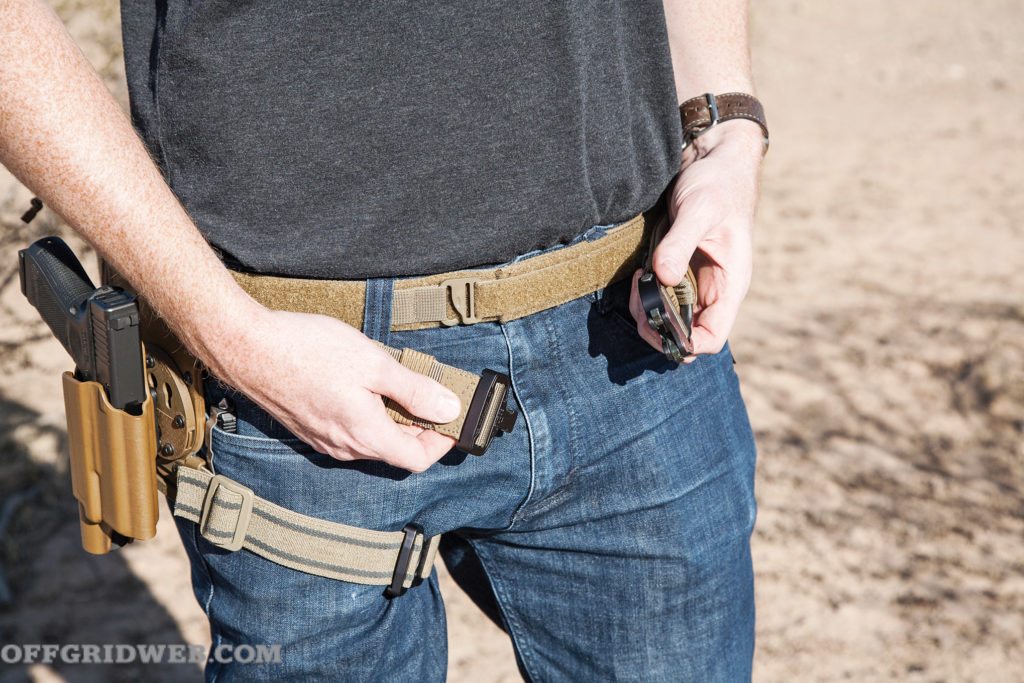
Above: Removal of the G-Code belt is simple: Disconnect the Cobra buckles on the belt and leg strap, then pull the hook-and-loop material apart. The inner belt will keep your pants where they belong.
To make use of the RTI Rotating Belt Mount, I picked up an RTI-compatible med pouch from G-Code. Alternatively, a standard med pouch could be attached directly to the belt using clips or MOLLE-compatible soft loops.
Notes: Measuring 6 by 5 by 2 inches, this zippered clamshell pouch is lined with an array of elastic loops for medical supplies. I filled it with supplies for major trauma and range-day cuts/scrapes: C-A-T tourniquet, Rescue Essentials pressure dressing, QuikClot hemostatic gauze, NAR S-rolled gauze, HyFin Vent chest seals, shears, medical tape, assorted Band-Aids, antiseptic wipes, gloves, and a mini Sharpie marker. The pouch itself is great, but I’m not sold on the RTI mounting system for this application — it causes the med kit to stick out further off the belt, making it feel a little cumbersome. A direct-mount kit would work better, unless you need to swap pouches frequently.
G-Code Contact Med Pouch
I finished off the range belt setup with the following items:
A war belt or battle belt takes the concept of a range belt to the next level, offering a platform that can be worn in a professional context along with other load-bearing gear. You might wear a range belt a few weekends each month, but duty belts for law enforcement and military personnel need to withstand continuous daily wear. That includes high-intensity activities like running, climbing, and hand-to-hand fighting, as well as long periods of walking, standing, or sitting. Durability and comfort are paramount, as is retention of all equipment — I shouldn’t have to explain why losing control of your weapon or other gear in a real fight would be disastrous.
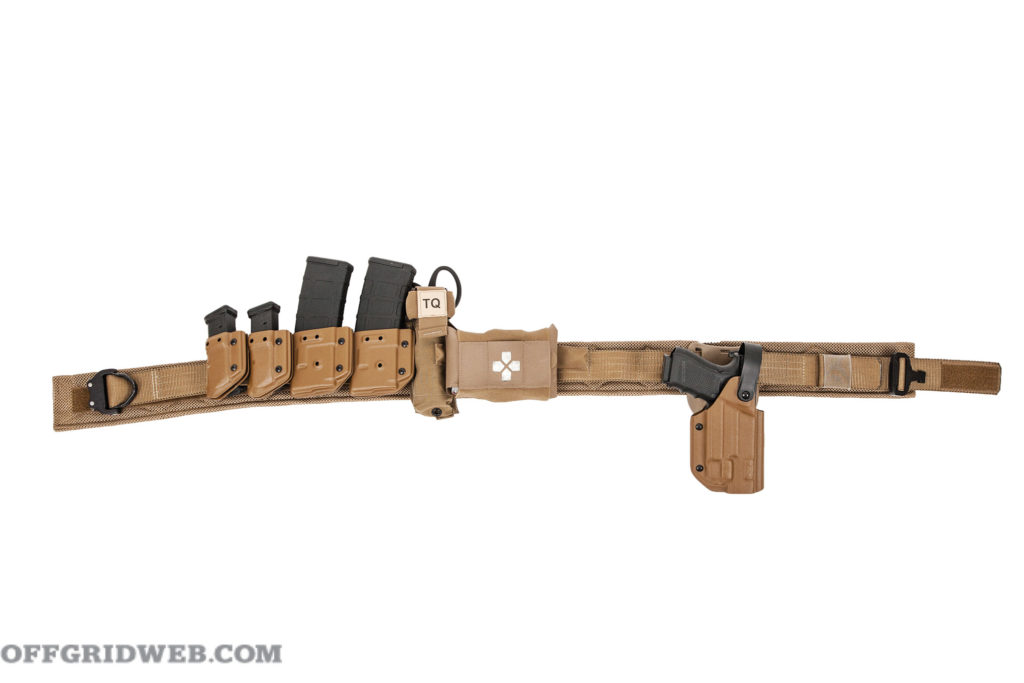
Above: We combined the Snake Eater Tactical three-piece War Belt with a Level 2 retention holster and Kydex mag carriers from VEIL Solutions. This setup is maneuverable and comfortable enough to wear while running, jumping, climbing, or crawling.
Wide, padded belts are standard in this category, since they provide the most comfort and support for heavier loadouts. The most traditional approach is to slide a belt through a padded sleeve that’s covered in MOLLE webbing. These sleeved systems can be worn over untucked shirts or jackets since they aren’t attached to the user’s pants. However, they’re bulky and may shift or rotate during physical activity — that’s not ideal if you expect to find your gear in the same place every time.
Suspenders (as seen on old U.S. military ALICE systems) and belt keeper loops (as seen on many LE duty belts) have been used to prevent movement, but Velcro hook-and-loop layers are a more modern solution. The belt I selected comes from Snake Eater Tactical, and features three layers connected in this manner.
Snake Eater Tactical War Belt System
The Foundation: The SET War Belt Three-Part System starts with a thin and light piece of 1.5-inch Hypalon fabric, with a simple pass-through loop on one end for tensioning. This is the absolute minimum needed to hold up a pair of pants, but it’s effective. Next, a 4mm-thick layer of closed-cell foam is wrapped in breathable nylon mesh, with hook material sewn to one side and loop material sewn to the other. This creates a thin yet breathable padded layer between the inner and outer belts. It’s wider than the other belt layers in order to provide cushioning for holster mounts and other hard accessories. Finally, the 1.75-inch outer belt is constructed from a double layer of Type 13 nylon parachute webbing, with an inner layer of hook material and a black Cobra buckle. Heavily reinforced stitching throughout this belt shows that it was built with longevity in mind. The SET War Belt is made to order; at time of publication, with a lead time of four to eight weeks.
This three-part system can be used as a two-part system. For example, the middle and outer layers can be worn over a jacket or untucked shirt, much like a traditional padded belt (with the aforementioned drawbacks). The middle layer can be removed for a slightly slimmer waist profile, but after wearing the full system, I can’t imagine wearing it without the padding — it makes a huge difference. The SET War Belt is head and shoulders above a regular range belt for long-term daily wear.
Given the nature of this belt setup, an active retention holster is a logical choice. Passive retention, as seen on the other holsters in this article, relies on friction induced by the shape of the holster to keep the weapon in place. Pull hard enough, and it’ll pop out. Active retention adds at least one device that must be released before drawing the gun. It ensures the gun won’t get knocked loose while you’re running around, or more importantly, won’t be easily accessible to any bad guy who tries to take it.
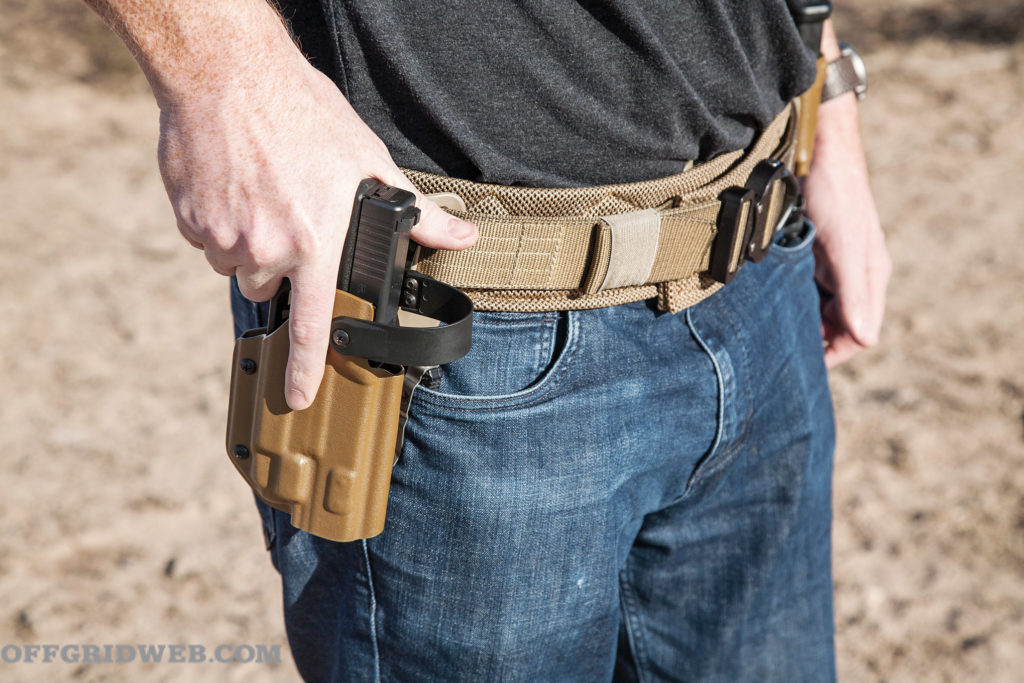
Above: Pressing the thumb break lever causes the retention hood to snap forward, allowing the gun to be drawn normally. This takes some getting used to, but it beats losing your gun.
Notes: The Fett features a thumb break — essentially a small lever on the inside edge of the holster — that must be pressed firmly to release a spring-loaded hood. When the hood flips forward, the gun can be drawn normally from passive retention. Each holster is drilled for various mounting patterns including Safariland, G-Code RTI, and Tek-Lok; I picked the ubiquitous Safariland Mid-Ride hanger ($20 extra). It’d be easy to add a thigh strap to this setup if desired, but I felt it was stable enough without one. Even though I’m not working at an LE agency or other job that requires a retention holster, I appreciate the peace of mind it provides. You never know when you might want to do some tactical cartwheels. When the hood isn’t activated, the Fett works great for range practice or competition.
VEIL Solutions Fett Duty Holster
While my range belt came with three rifle mags and three pistol mags, I picked up two and two for the war belt. This is because I’d typically wear it with other load-bearing gear that contains more magazines, such as a chest rig or plate carrier.
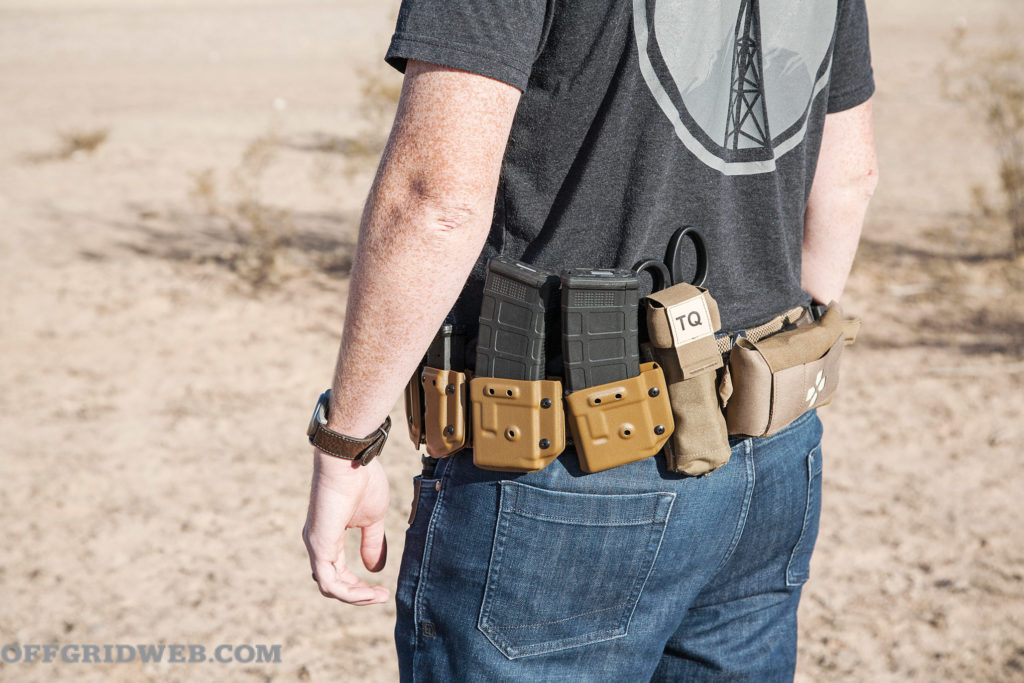
Notes: Universal mag pouches have pros and cons, but application-specific, molded Kydex carriers provide the most secure fit and retention. They’re also durable and easy to clean. VEIL Solutions’ C2 series, which stands for Competition & Carry, is available with a reversible polymer belt clip or an optional Tek-Lok clip ($8 extra per carrier). The pistol carriers are available for Glock, SIG, HK, CZ, 2011, and B&T applications; the rifle carriers are available for AR-15, AR-10, and AK mags. Numerous finishes and colors are offered, from plain black to Rhodesian Brushstroke. I’m a fan of the slim profile and strong retention provided by these C2 carriers.
VEIL Solutions V2 Pistol Mag Carriers/Rifle Mag Carriers
Much like the magazines, this medical gear is supplemented by gear in my chest rig or plate carrier. This belt IFAK serves as my first-line trauma gear. Second-line trauma gear and “boo-boo” kit items are stored elsewhere.
Notes: The Micro TKN consists of an elastic sleeve and a tear-away insert that can be pulled out using the tabs on either end. It can be purchased fully loaded or empty; I packed mine with an H&H mini compression bandage, QuikClot hemostatic gauze, HyFin Vent Compact chest seals, medical tape, and gloves.
North American Rescue C-A-T Holder
Since my micro trauma kit doesn’t have room for a standard TQ, I picked up this carrier from NAR. It attaches securely to the belt with snap straps, and has an elastic cover that protects the Velcro on the C-A-T tourniquet from dirt or abrasions. The straps on the back offer a convenient place to store a set of shears.
Just because you can load down your war belt with six AR mags, four pistol mags, throwing knives, and shark-repellent spray doesn’t mean you should. The only item I’d consider adding is a dump pouch if the situation called for it. It can be used for cycling through a large number of partial mags during reload drills, picking up brass at the end of a range session, or carrying loose ammo for specific weapons (e.g. shotguns).
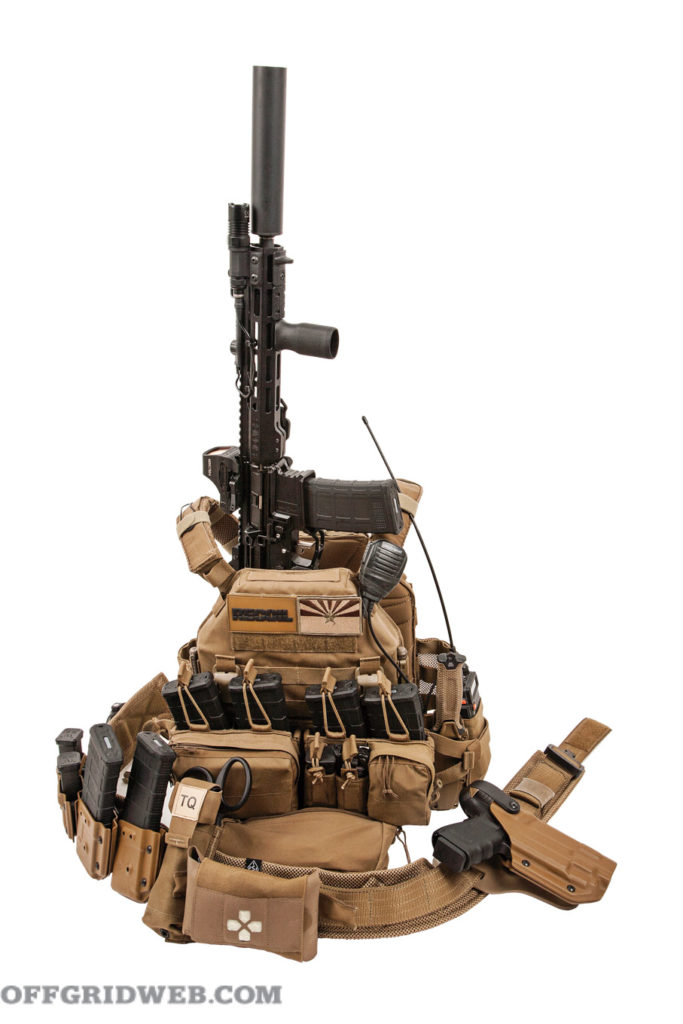
Above: A war belt will often serve as one piece of a larger load-bearing gear system, such as this Tyr Tactical PICO-DS plate carrier. See our article Here for a detailed look at all of its components.
Much like the emergency preparedness “line gear” Tom Marshall wrote about in Issue 38, it’s not unreasonable to have a few belt setups for different purposes. Many of you reading this article won’t need to spend a big chunk of change on a full-blown war belt. Virtually everyone needs a good everyday belt, unless you wear a bikini or silkies 24/7, in which case we hope you’re good at hand-to-hand combat and MacGyvering your way out of danger. Instead of building a jam-packed belt that would make Batman jealous, consider the situations you face most often, and focus on finding the most efficient way to carry what you truly need.
 STAY SAFE: Download a Free copy of the OFFGRID Outbreak Issue
STAY SAFE: Download a Free copy of the OFFGRID Outbreak Issue
No Comments